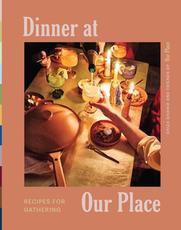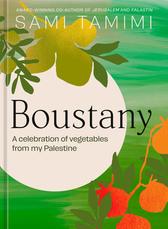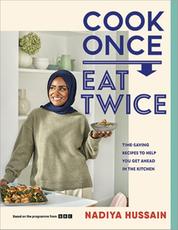Here's an array of even more cookbooks and food writing, reviewed over the course of the year. We think they'll make your holiday feasting delicious and plentiful!
 Shiza Shahid, CEO of the viral Our Place cookware brand, invites home cooks into an "ideal world" where we're all "throwing dinner parties at least once a month" in Dinner at Our Place: Recipes for Gathering (Harvest Publications). With input from 11 additional home cooks (many of whom are chefs, but all of whom are known as "host, curator, gathering specialist"), the recipes here are combined with menus, conversation topics, bar suggestions, tablescapes, plating advice, and playlist recommendations to offer a year's worth of dinner party ideas for readers, one for each month. --Kerry McHugh
Shiza Shahid, CEO of the viral Our Place cookware brand, invites home cooks into an "ideal world" where we're all "throwing dinner parties at least once a month" in Dinner at Our Place: Recipes for Gathering (Harvest Publications). With input from 11 additional home cooks (many of whom are chefs, but all of whom are known as "host, curator, gathering specialist"), the recipes here are combined with menus, conversation topics, bar suggestions, tablescapes, plating advice, and playlist recommendations to offer a year's worth of dinner party ideas for readers, one for each month. --Kerry McHugh
 Boustany: A Celebration of Vegetables from My Palestine by Sami Tamimi (Ten Speed) presents a colorful profusion of recipe flavors anchored in traditional Arabic culture and re-created by the author to delight contemporary palates. The book features more than 100 recipes, each preceded by a brief explanation of its provenance, and visually striking photographs that will entice even the most reluctant cook into the kitchen. "The beauty of Palestinian cuisine lies in its versatility," Tamimi explains, and he encourages experimentation with his brunch-friendly ijeh (Arabic frittata), weekday dinner items such as celeriac and tomato bake, and an apricot and almond cake. Rice pudding is a popular Arabic dessert, and it's crafted here with a tahini base and grape compote. Boustany's spectacular selection of sweets also includes labneh and pomegranate ice cream and a surprisingly simple but scrumptious mango parfait. --Shahina Piyarali
Boustany: A Celebration of Vegetables from My Palestine by Sami Tamimi (Ten Speed) presents a colorful profusion of recipe flavors anchored in traditional Arabic culture and re-created by the author to delight contemporary palates. The book features more than 100 recipes, each preceded by a brief explanation of its provenance, and visually striking photographs that will entice even the most reluctant cook into the kitchen. "The beauty of Palestinian cuisine lies in its versatility," Tamimi explains, and he encourages experimentation with his brunch-friendly ijeh (Arabic frittata), weekday dinner items such as celeriac and tomato bake, and an apricot and almond cake. Rice pudding is a popular Arabic dessert, and it's crafted here with a tahini base and grape compote. Boustany's spectacular selection of sweets also includes labneh and pomegranate ice cream and a surprisingly simple but scrumptious mango parfait. --Shahina Piyarali
 The practical, easy-to-follow Cook Once, Eat Twice (Sourcebooks) takes inspiration from Nadiya Hussain's television series of the same name to offer home chefs of every skill level "a cookbook that... has all the essentials anyone would need." Hussain, a past winner of The Great British Bake Off, delivers on that promise--and then some--with approachable recipes and instructions. "Cook once" is reflected in how-to basics such as poached eggs or simple roasted chicken, while "eat twice" comes to life with inspired ideas for reusing leftovers and batch cooking that specifically call for repurposing a double batch of food. These recipes are sure to encourage anyone looking to creatively use and reuse common ingredients for maximum flavor and frugality. --Kerry McHugh
The practical, easy-to-follow Cook Once, Eat Twice (Sourcebooks) takes inspiration from Nadiya Hussain's television series of the same name to offer home chefs of every skill level "a cookbook that... has all the essentials anyone would need." Hussain, a past winner of The Great British Bake Off, delivers on that promise--and then some--with approachable recipes and instructions. "Cook once" is reflected in how-to basics such as poached eggs or simple roasted chicken, while "eat twice" comes to life with inspired ideas for reusing leftovers and batch cooking that specifically call for repurposing a double batch of food. These recipes are sure to encourage anyone looking to creatively use and reuse common ingredients for maximum flavor and frugality. --Kerry McHugh
 Nina Mukerjee Furstenau's The Pocket Rhubarb Cookbook (Belt Publishing) is a delectable tribute to the bright, tart vegetable whose uses are far more varied than popular crisps and pies. Furstenau expands the repertoire to breakfast breads, muffins, and cookies before turning to savory mains. She goes far beyond the typical pork tenderloin and adds a dash (or a dollop) of rhubarb to lamb stew, curries, lentil dishes, and even barbecued ribs. Subsequent chapters cover drinks (including lemonade and lassi), jams and other preserves, and a wide variety of sauces (even ketchup). Furstenau's instructions are clear and concise, with short headnotes offering a hint about a recipe's origin or her favorite variation. --Katie Noah Gibson, blogger at Cakes, Tea and Dreams
Nina Mukerjee Furstenau's The Pocket Rhubarb Cookbook (Belt Publishing) is a delectable tribute to the bright, tart vegetable whose uses are far more varied than popular crisps and pies. Furstenau expands the repertoire to breakfast breads, muffins, and cookies before turning to savory mains. She goes far beyond the typical pork tenderloin and adds a dash (or a dollop) of rhubarb to lamb stew, curries, lentil dishes, and even barbecued ribs. Subsequent chapters cover drinks (including lemonade and lassi), jams and other preserves, and a wide variety of sauces (even ketchup). Furstenau's instructions are clear and concise, with short headnotes offering a hint about a recipe's origin or her favorite variation. --Katie Noah Gibson, blogger at Cakes, Tea and Dreams
 Andreas Ammer's Portrait of an Oyster (Greystone) is pure pleasure--an immersion in the science, art, philosophy, history, and gastronomy of a deceptively simple creature, the oyster. It gracefully navigates the microscopic intricacies of oyster anatomy and the grander narratives of oyster cultivation and global trade, as well as the periods of individual indigenous oyster extinction and the expansion of non-native species. Falk Nordmann provides exquisite illustrations alongside facsimiles of paintings (for example, Édouard Manet's Luncheon in the Studio), photographs, detailed diagrams, and other historical artworks, even including a set of French collectible cards that pose the question, "What is an oyster?" --Elizabeth DeNoma, executive editor, DeNoma Literary Services, Seattle, Wash
Andreas Ammer's Portrait of an Oyster (Greystone) is pure pleasure--an immersion in the science, art, philosophy, history, and gastronomy of a deceptively simple creature, the oyster. It gracefully navigates the microscopic intricacies of oyster anatomy and the grander narratives of oyster cultivation and global trade, as well as the periods of individual indigenous oyster extinction and the expansion of non-native species. Falk Nordmann provides exquisite illustrations alongside facsimiles of paintings (for example, Édouard Manet's Luncheon in the Studio), photographs, detailed diagrams, and other historical artworks, even including a set of French collectible cards that pose the question, "What is an oyster?" --Elizabeth DeNoma, executive editor, DeNoma Literary Services, Seattle, Wash
 Caroline Eden's sumptuous Cold Kitchen (Bloomsbury) harvests memories and recipes from the author's travels in Central Asia and Eastern Europe. The dozen chapters--three per season--cover an archetypal year. In Proustian fashion, smells and tastes evoke other times and places. As she prepares a watermelon, feta, and mint salad, she remembers asking a taxi driver to wait at the roadside so she could buy winter melons in Uzbekistan. To relive a Trans-Siberian railway trip, she bakes Russian hand pies stuffed with sauerkraut and hard-boiled eggs. Some dishes also bring to mind turbulent events: not long after Eden shared a duck plov at a friend's Kyrgyzstan dacha, news came of the overthrow of that country's president. Keeping cultural and food traditions alive offers a way of honoring a place's history--sorrow and all. --Rebecca Foster, freelance reviewer, proofreader and blogger at Bookish Beck
Caroline Eden's sumptuous Cold Kitchen (Bloomsbury) harvests memories and recipes from the author's travels in Central Asia and Eastern Europe. The dozen chapters--three per season--cover an archetypal year. In Proustian fashion, smells and tastes evoke other times and places. As she prepares a watermelon, feta, and mint salad, she remembers asking a taxi driver to wait at the roadside so she could buy winter melons in Uzbekistan. To relive a Trans-Siberian railway trip, she bakes Russian hand pies stuffed with sauerkraut and hard-boiled eggs. Some dishes also bring to mind turbulent events: not long after Eden shared a duck plov at a friend's Kyrgyzstan dacha, news came of the overthrow of that country's president. Keeping cultural and food traditions alive offers a way of honoring a place's history--sorrow and all. --Rebecca Foster, freelance reviewer, proofreader and blogger at Bookish Beck

